Topic outline
-
-
In this unit you will learn about:
- cells, and their main characteristics
- different types of cells
- the differences between plant and animal cells
- cell differentiation, formation of tissues and organs
-
-
-
What are cells?
All life on Earth is made from cells. Without cells, there can be no life.
Almost all cells are so small that you need a microscope to see them. Some organisms, like bacteria are made of only one cell. These are unicellular organisms.
Others, like trees and blue whales, are made from millions or even billions of cells. These are multicellular organisms.
Cells are the basic, fundamental unit of life. So, if we were to break apart an organism to the cellular level, the smallest independent component that we would find would be the cell.
Animals and plants are multicellular organisms – they consist of many cells that work together. A living thing, whether made of one cell (like bacteria) or many cells (like a human), is called an organism. So, cells are the basic building blocks of all organisms.
Animal cell structure
The main parts of an animal cell are the nucleus, cell membrane, cytoplasm, and mitochondria.
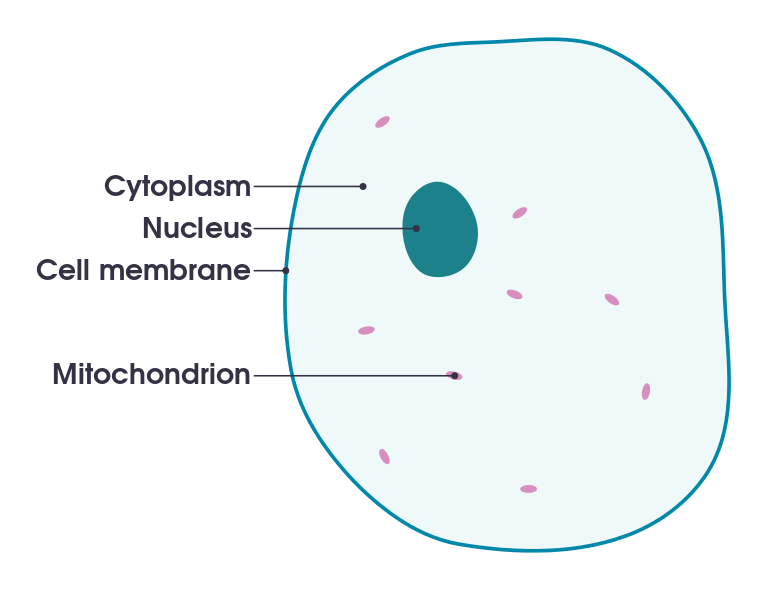
Figure 1: A simple diagram of an animal cell. Image: domdomegg. (2016). CCA 4.0
Plant cell structure
Plant cells contain the same features as animal cells. They also have some additional ones:
- chloroplasts
- cell wall made of cellulose
- large central vacuole
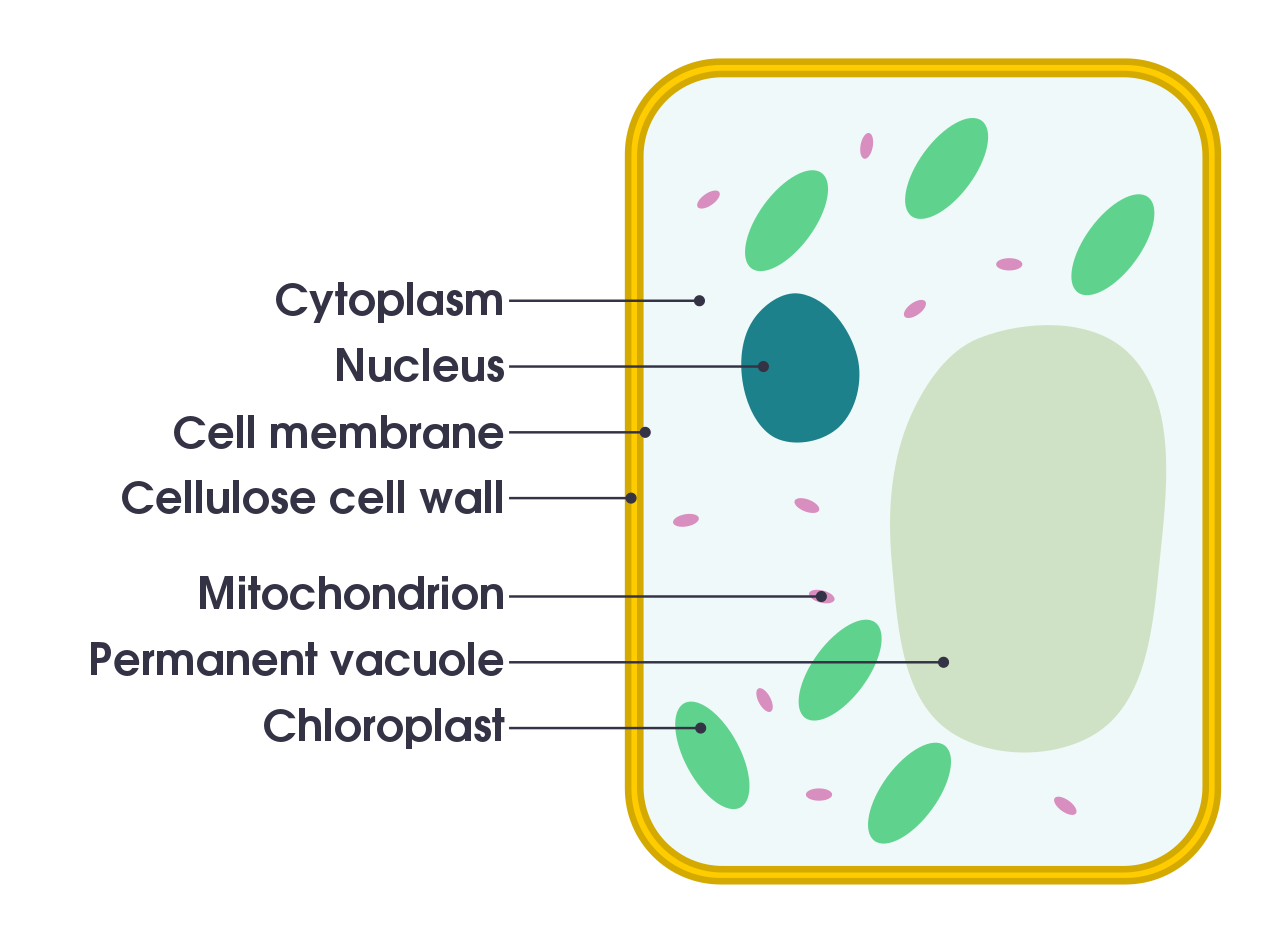
Figure 2: A simple diagram of a plant cell. Image: domdomegg. (2016). CCA 4.0
What's in a cell?
Cells are the basic building blocks of all animals and plants.
Inside cells are various structures that are specialised to carry out a particular function. Both animal and plant cells have these components:
- Cell membrane – this surrounds the cell and allows nutrients to enter and waste to leave it.
- Nucleus – this controls what happens in the cell. It contains DNA, the genetic information that cells need to grow and reproduce.
- Cytoplasm – this is a jelly-like substance in which chemical reactions happen.
- Mitochondria – these are the powerhouse of the cell. They are structures where respiration takes place.
How are plant and animal cells different?
Plant cells have all the parts in the list above, plus a few extra structures:
- Cell wall - this is an outer structure that surrounds the cell and gives it support.
- Vacuole - this is a space within the cytoplasm of plant cells that contains sap.
- Chloroplasts - these contain chlorophyll and are the site of photosynthesis.
Summary of features found in cells and their functions:
Cells are too small to be seen by the naked eye. To see them you would need to use a microscope.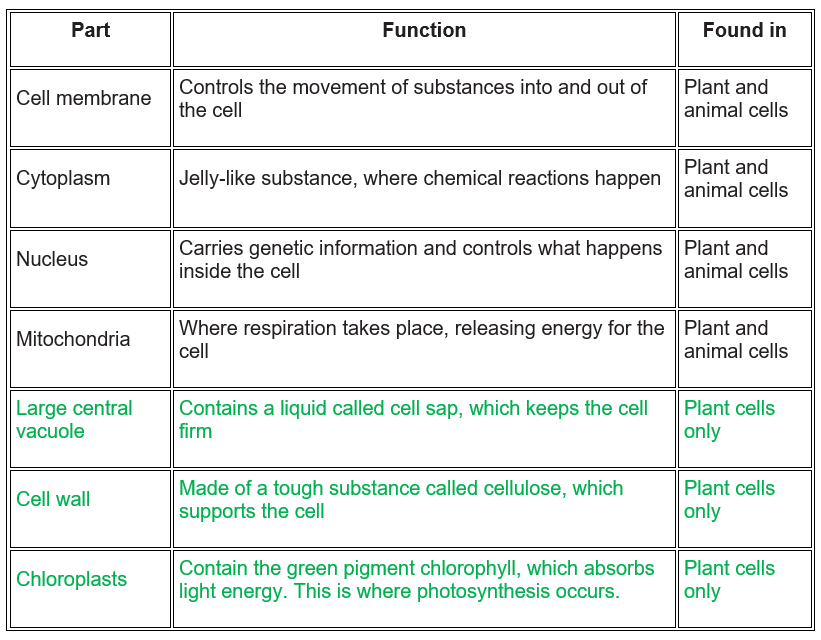
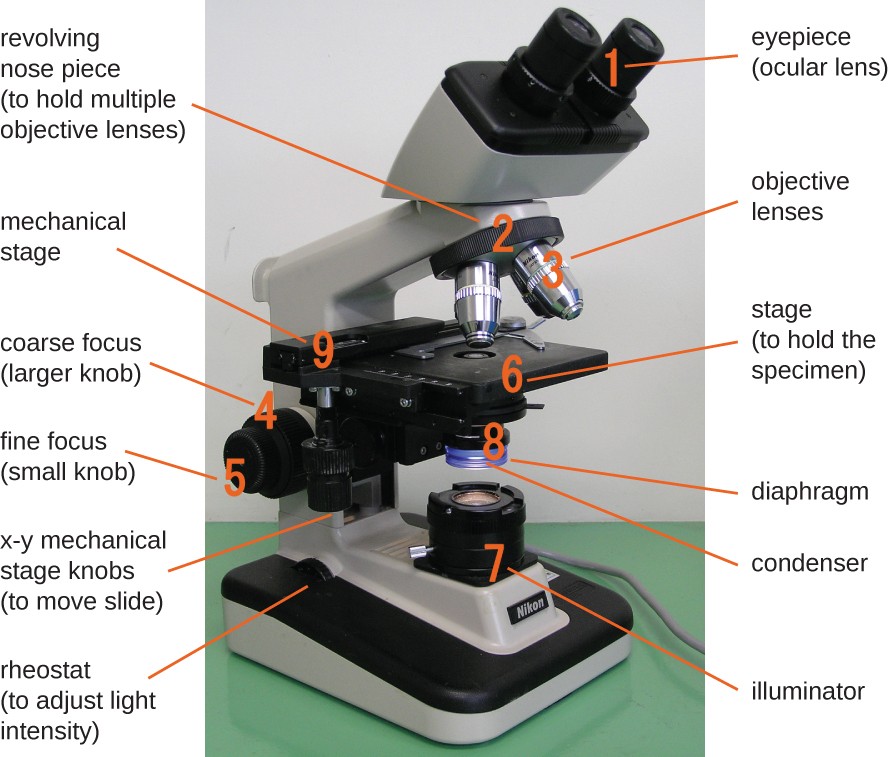
Image: OpenStax. CC BY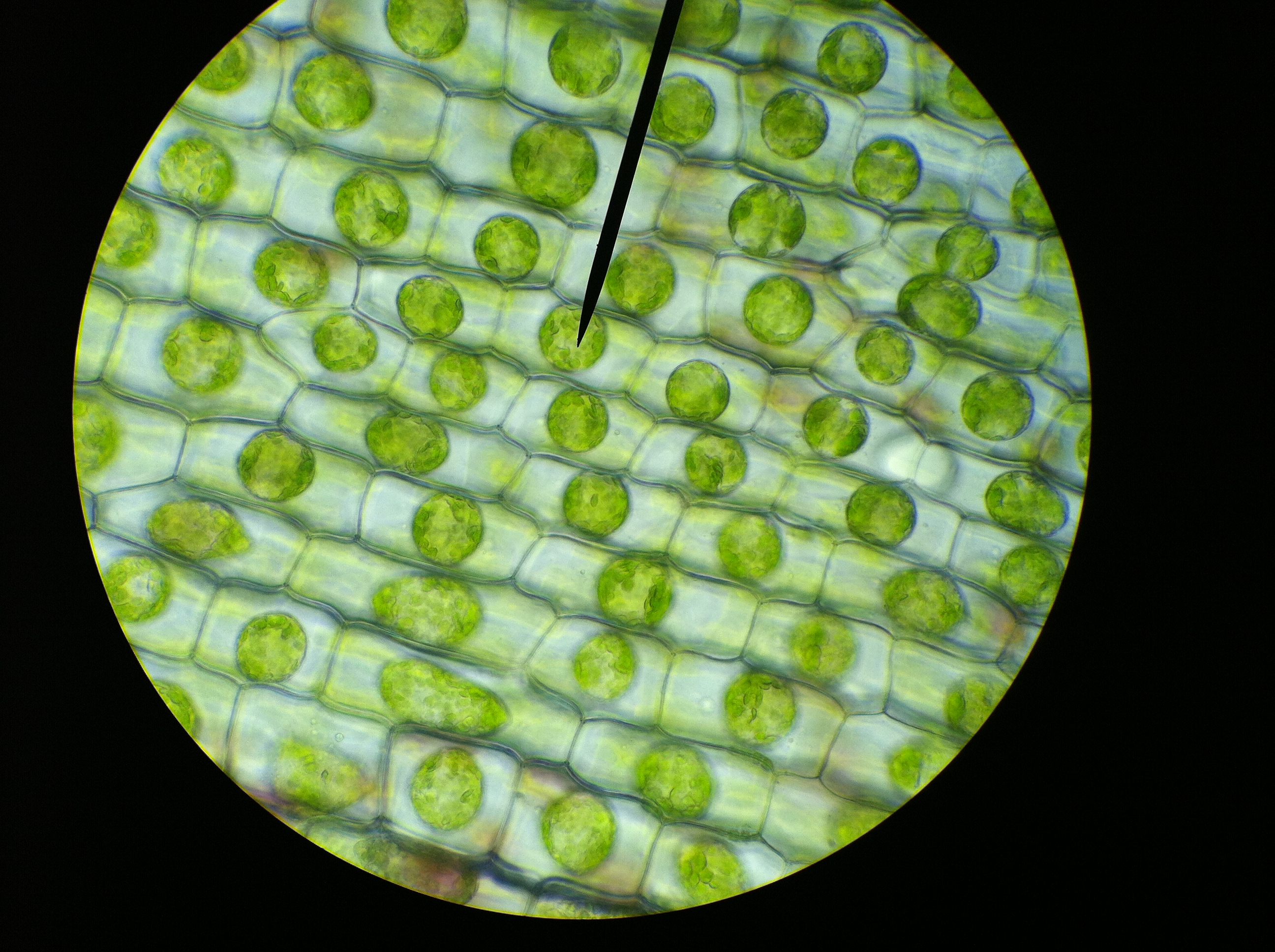
Figure 3: Plant cells under a microscope. The bright green blobs you can see are the nucleus of each cell. You can also see the cell wall. Image: fickleandfreckled. CC BY 2.0
Credit: Fuse Schools- Global Education. Introduction to Cells.
-
-
-
Most cells share features such as having a nucleus, a cell membrane, cytoplasm, and mitochondria. Plant cells tend to be larger than animal cells and have a cell wall, a vacuole and most plant cells have chloroplats.
There are differences between cells. Each type of cell has its own job to do. These cells have specific features that allow them to perform their functions effectively.
Cellular differentiation is the process in which a stem cell changes from one type to a differentiated one. Usually, the cell changes to a more specialized type. Differentiation happens multiple times during the development of a multicellular organism as it changes from a simple zygote to a complex system of tissues and cell types. Differentiation continues in adulthood as adult stem cells divide and create fully differentiated daughter cells during tissue repair and during normal cell turnover.
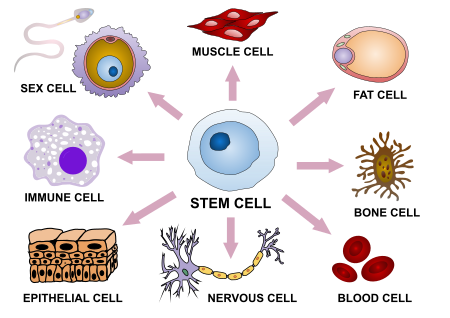
Image: Haileyfournier. CC BY-SA 4.0
Specialised animal cells:
Red blood cells:
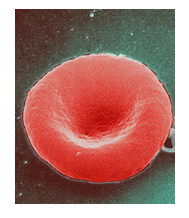
Image: Open Learning Initiative. CC BY-NC-SA
Red blood cells carry oxygen around the body. They are well suited to this function because:
- They contain haemoglobin, which carries oxygen molecules.
- They don't have a nucleus, allowing more space to carry oxygen.
- They are a flat disc shape (biconcave) which gives them a large surface area, and the best chance of absorbing as much oxygen as they can.
Nerve cells transmit electrical signals. They are well suited to their function because:
- They are thin and can be more than 1 metre long. This means they can carry messages up and down the body over large distances.
- Nerve cells have branched connections at each end. These join to other nerve cells, allowing them to pass messages around the body.
- They have a fatty (myelin) sheath that surrounds them. The fatty sheath increases the speed at which the message can travel.
A nerve cell is long and insulated with a fatty layer to carry electrical impulses around the body. Image: Emma Harrage. CC BY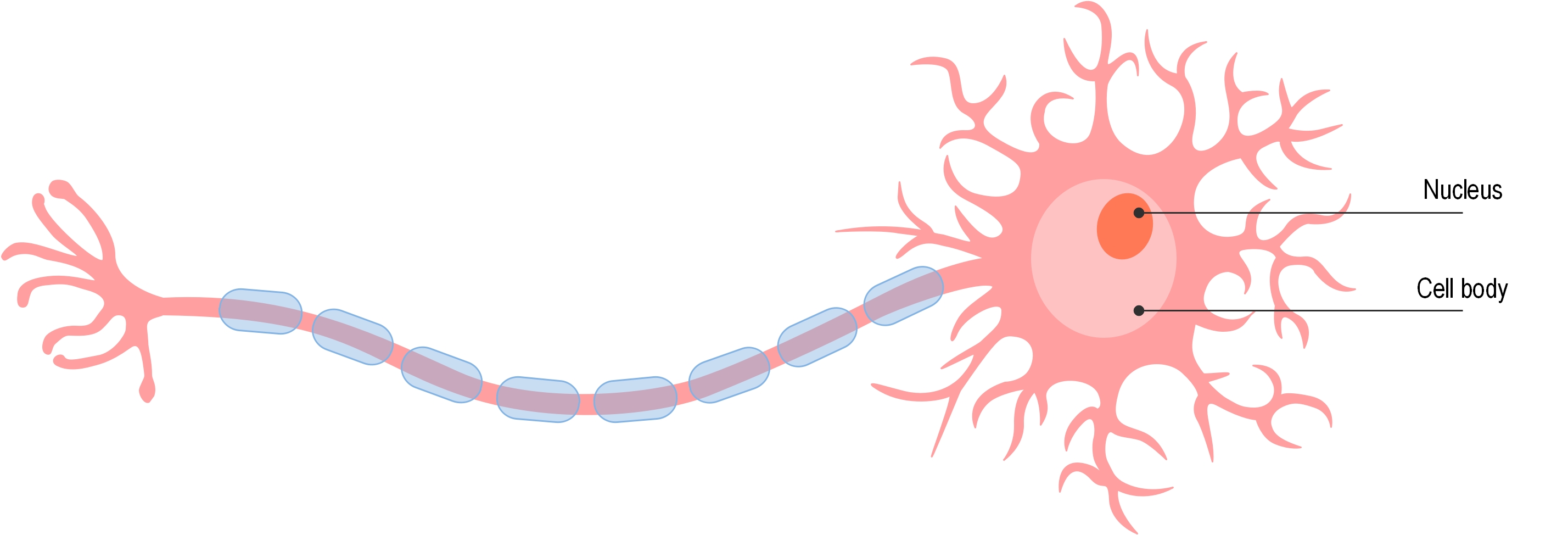
Muscle cells:

Image: CK-12 Foundation. CK-12 License - free to use for education purposes.
Muscle cells bring parts of the body closer together. They are well suited to this function because:
Muscle cells are held together in bundles, which pull together to make muscles contract (get shorter and fatter).
There are different types of muscle cell, each perfectly adapted to its function:
Cardiac muscle cells: Cardiac (heart) muscle cells are branched, and they join together to make a net. Cardiac muscle cells contract rhythmically, even outside the body. They never get tired.
Skeletal muscle cells: Skeletal muscle is joined to bones. Its cells contract to make bones move and joints bend.
Smooth muscle cells: Smooth muscle cells make up thin sheets of muscle, such as the stomach lining. They can also be arranged in bundles, or rings, like that in the anus.
Ciliated cells:
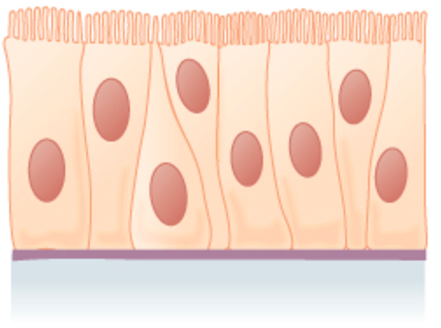
Image: Open Stax CC BY 3.0
Ciliated cells are found in the airways. They have tiny hairs on their tops called cilia which beat in a rhythm. These hairs move mucus containing dust and other particles upwards and out of the airways. Ciliated cells are also found in the oviducts. Here the tiny hairs beat to move the egg from the ovaries to the uterus.
Villi:
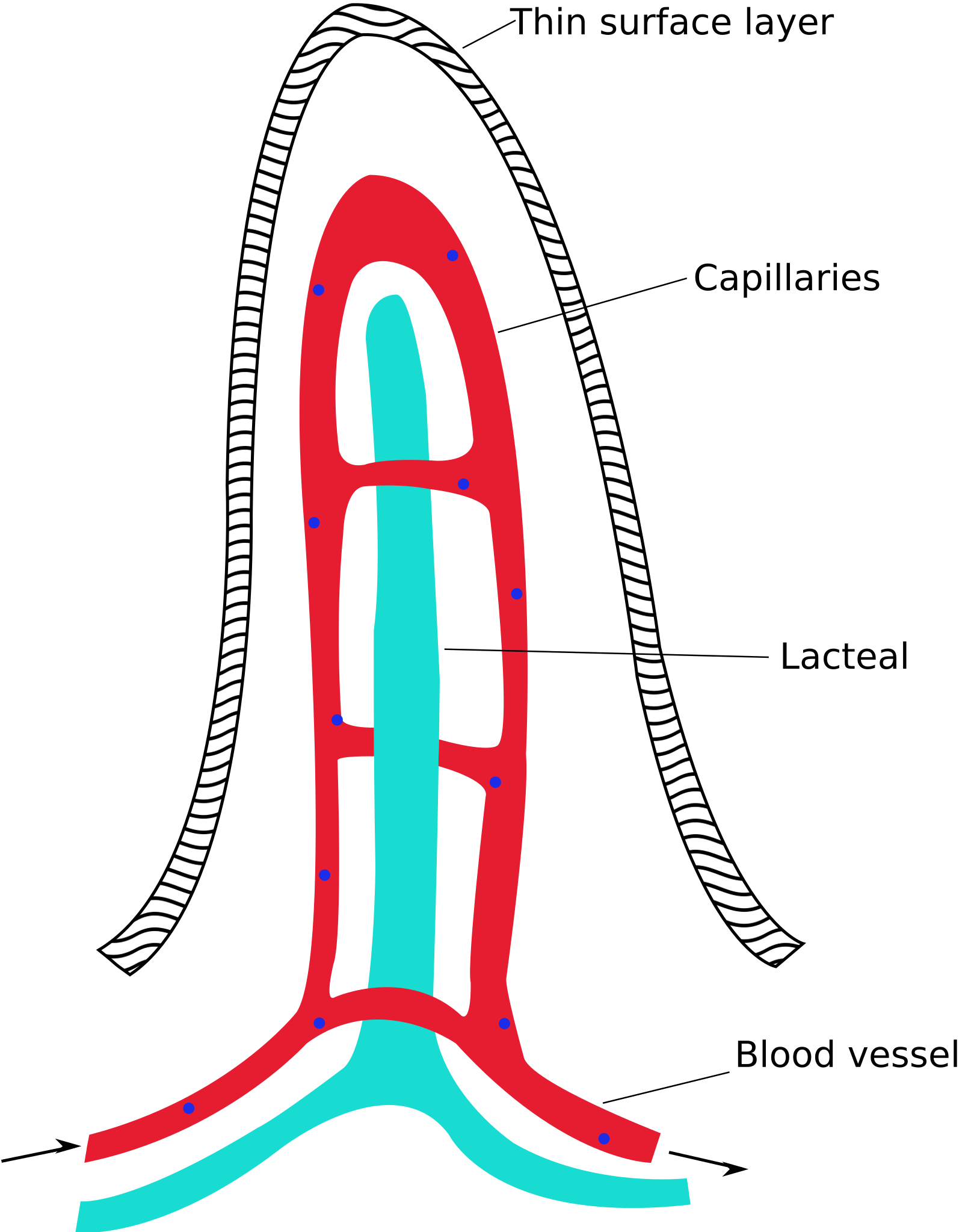
Image: snow93. Public domain
Villi are structures about one millimetre long in the small and large intestines. Millions of them poke out to absorb digested food and water into the blood. They are well suited to this function because:
- They have a large surface area.
- They have thin walls which are only one cell thick.
- The cells of the lining have tiny hairs to absorb more food and water.
Specialised plant cells:
Root hair cells:
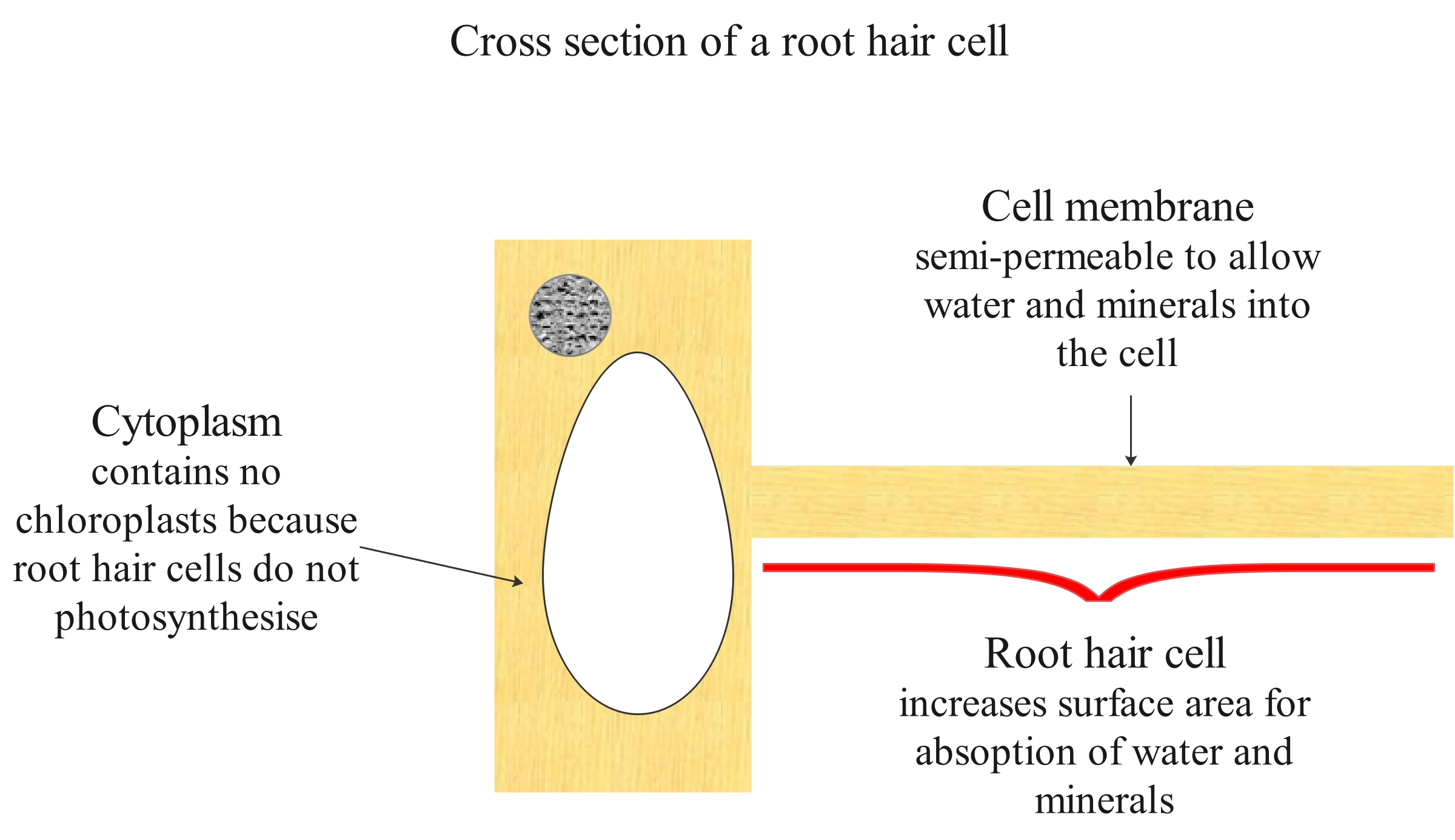
Image: Emma Harrage. CC BY
Roots hold plants in place as they grow and absorb water and minerals from the soil. Roots divide into smaller and smaller branches as they travel into the soil. The outside surface of root is covered with root hair cells, which have tiny 'hairs' which poke into the soil. This massively increases the surface area for the root hair cell to absorb more water and minerals.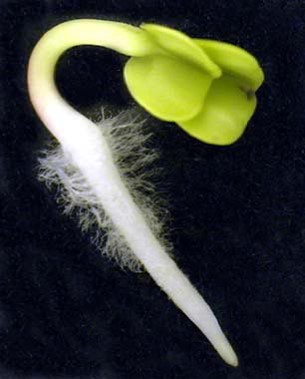
Image: wikiwijs. CC BY
Palisade cells:
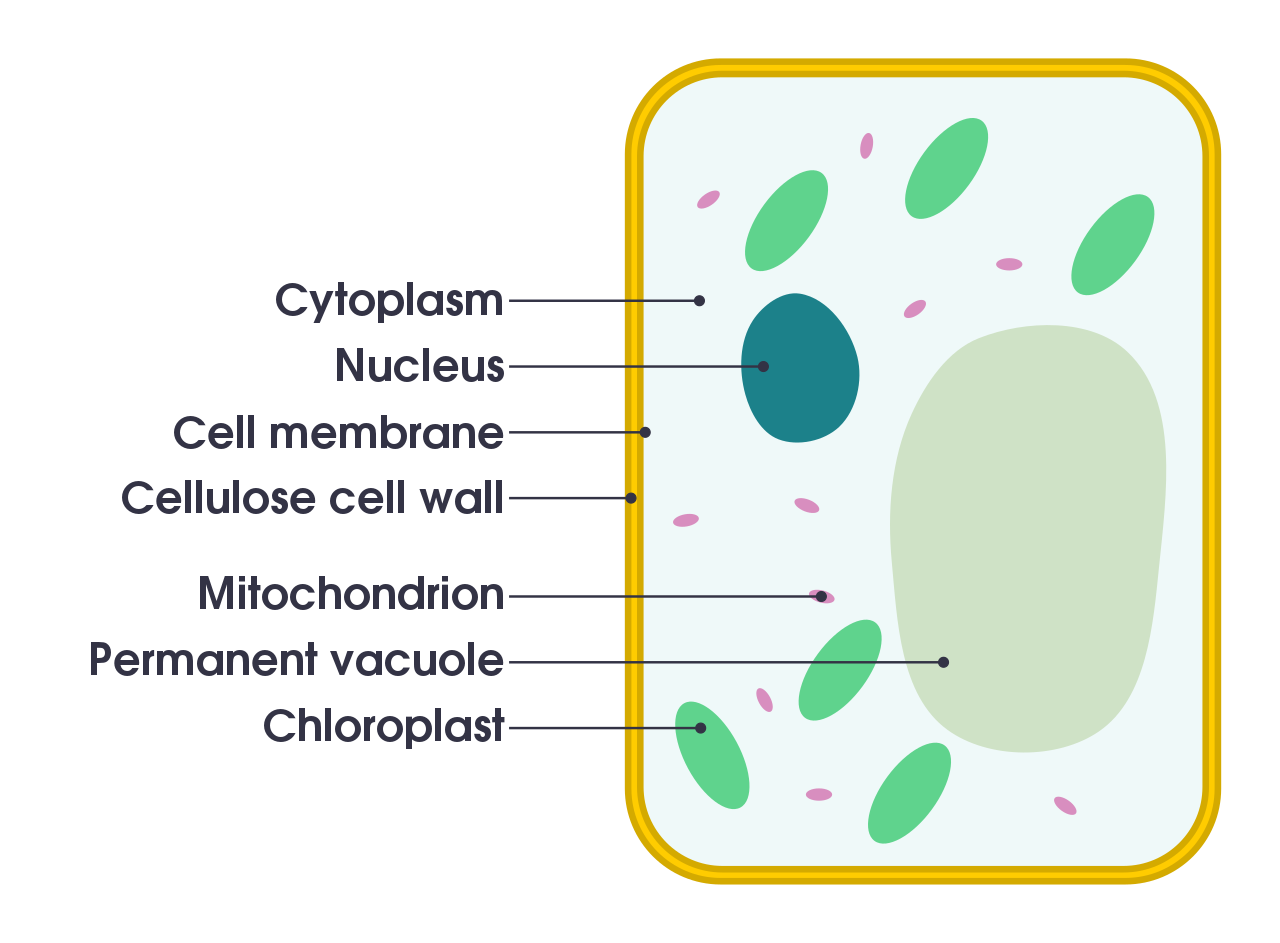
Image: domdomegg. CCA 4.0
When the Sun shines, photosynthesis in plant cells makes sugar for growth, reproduction, and other life processes. Photosynthesis occurs in a special chemical called chlorophyll, which is found in parts of plant cells called chloroplasts. Palisade cells are the major site of photosynthesis. They are well adapted for this function because:
- they are towards the tops of leaves for maximum light
- they have lots of chloroplasts
Xylem and phloem cells:
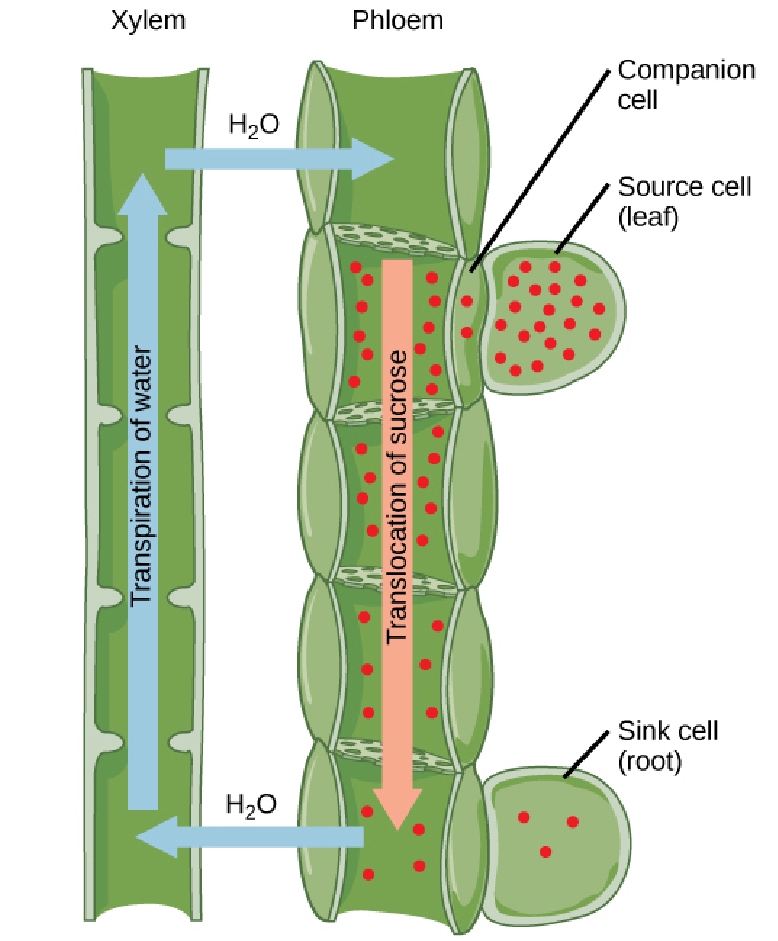
Image: OpenStax. CC BY
Xylem cells transport water from the roots to other parts of the plant. Xylem cells run inside stems of plants from their roots to their leaves. Xylem cells die and their ends break down. This allows them to form long tubes to carry water upwards for photosynthesis. They have thick cell walls to provide support to the plant. This holds the leaves up for photosynthesis and the flowers up for reproduction.
Phloem cells transport sugary water from the leaves to the rest of the plant. Phloem cells are often found near to xylem cells in the stem. Unlike xylem cells, phloem cells are alive. They carry sugary water from the leaves to the rest of the plant. Next to the phloem cells are companion cells which have many mitochondria.
Credit: Fuse Schools - Global Education.
-
-
-
Multicellular animals and plants consist of different types of cells organised in a hierarchy as tissues, organs, and systems.
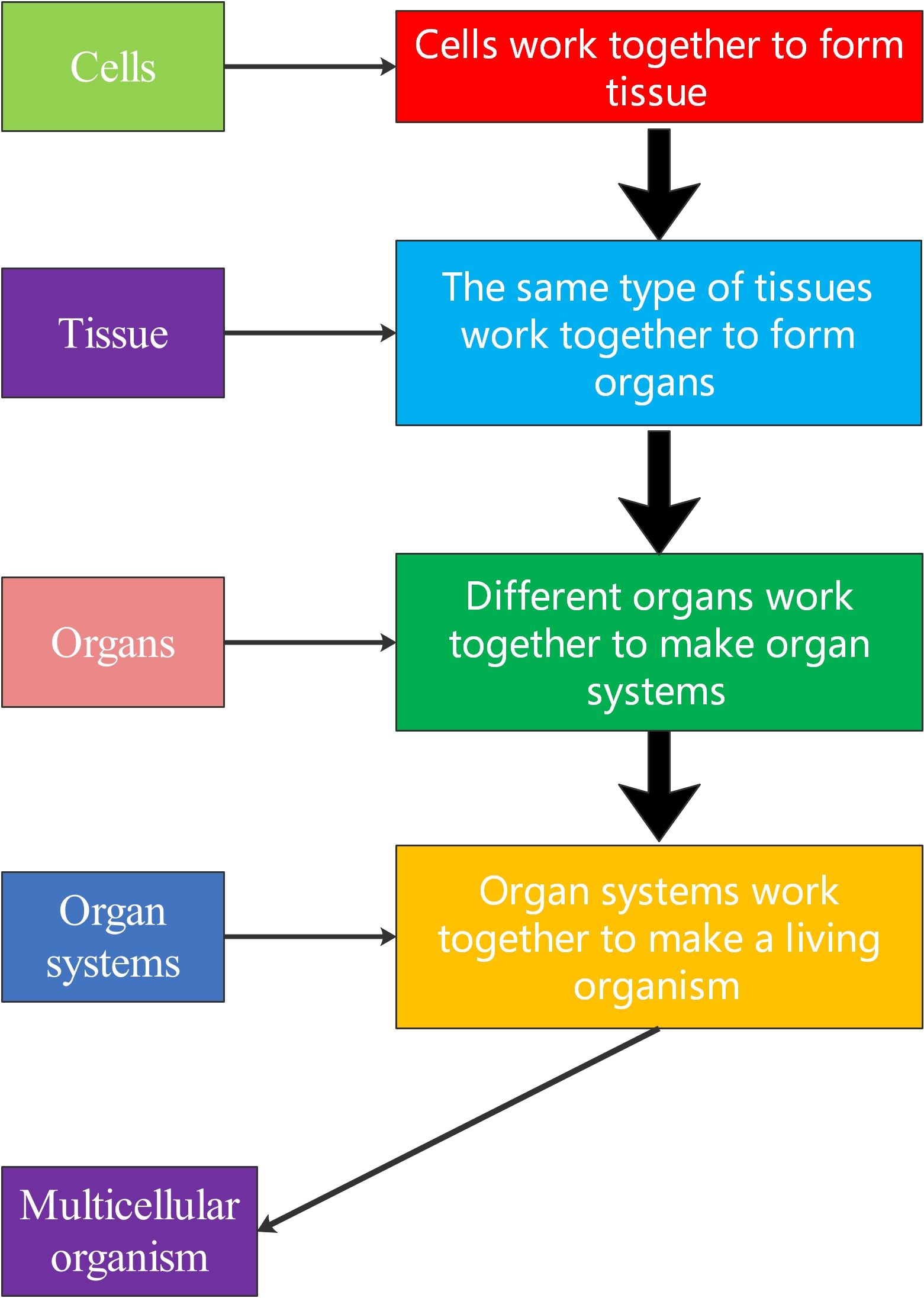
Image: Emma Harrage. CC BY
Cells: Cells are the smallest unit of life. Most cells have features which give them different functions within an organism.
The term tissue is used to describe a group of cells that are similar in structure and perform a specific function.
Tissues: A group of similar cells in the same place with the same function is a tissue.
Plants: In plants, dermal tissue covers the leaves, fruits, flowers, roots, and stems of plants. Dermal tissue stops the plant from losing too much water.
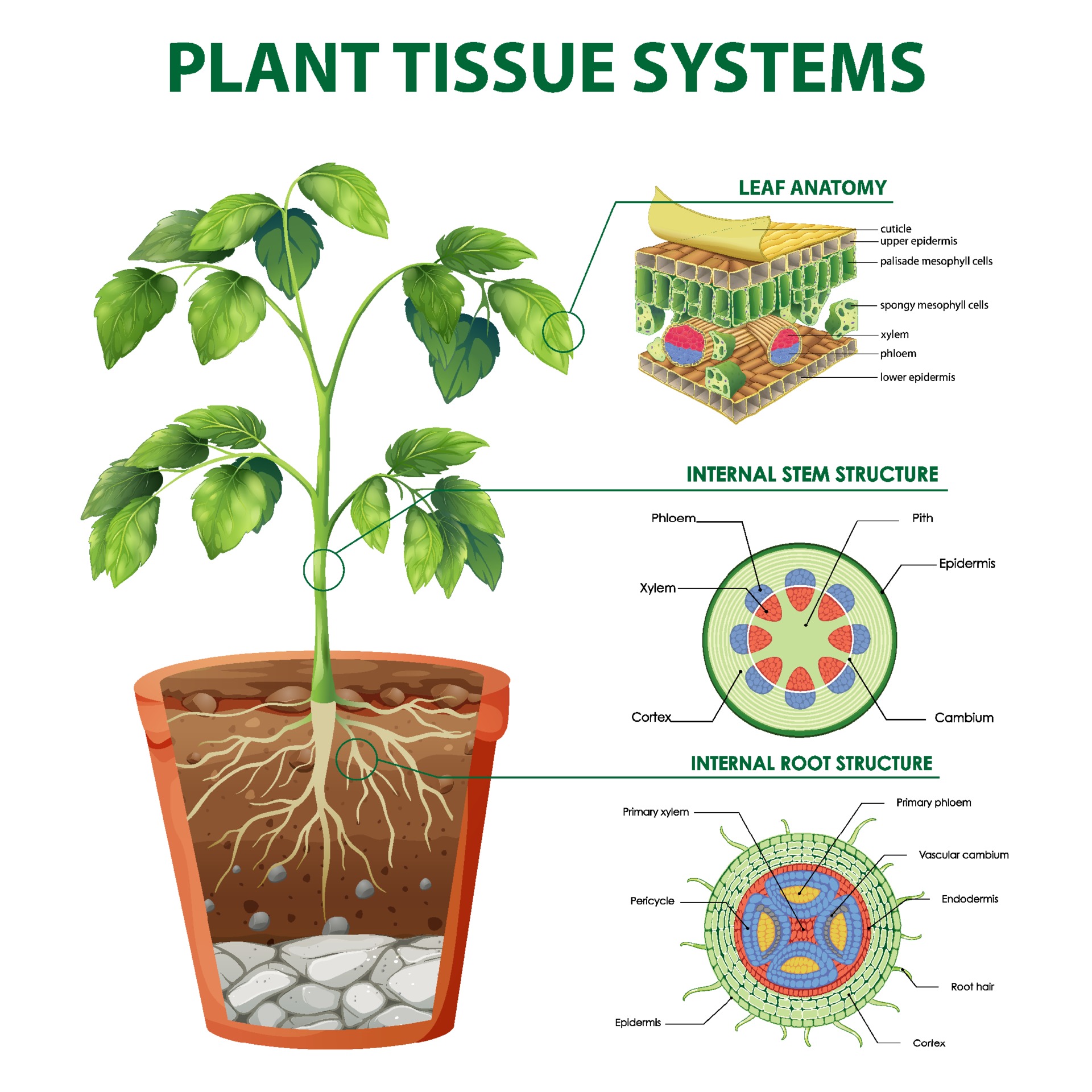
Image: Vecteezy.com. Public domain
Animals: Examples of tissues in animals include muscle tissue and nerve tissue.
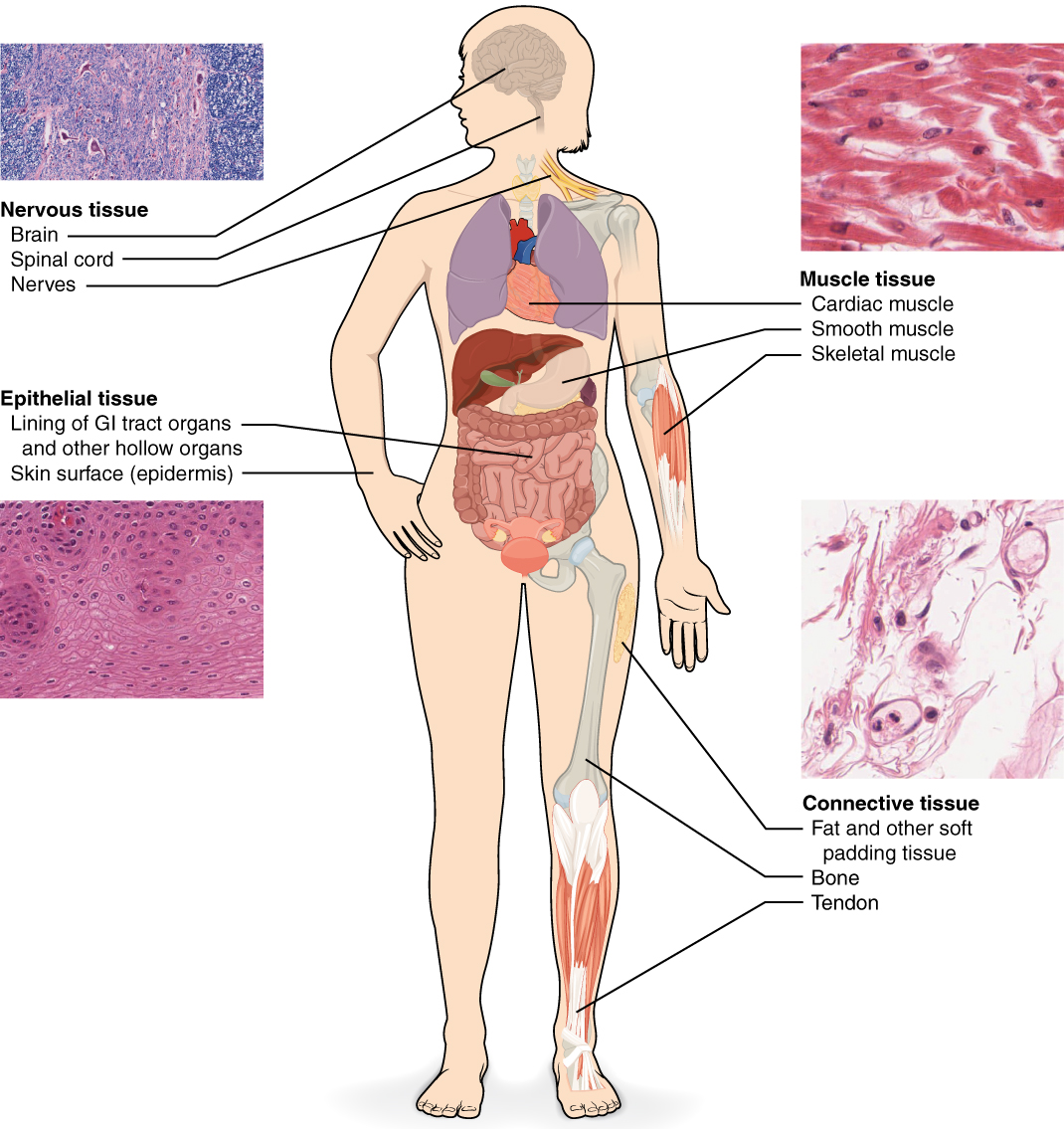
Image: Oregon State University. CCA 4.0
Muscle tissue: made of muscle cells that can contract and relax to move parts of the body.
Nerve tissue: made of nerves, found in the brain and spinal cord, and the network of nerves that spreads throughout the body. It sends electrical signals to control and coordinate actions.
Plants: Roots are plant organs. They keep plants securely in the ground and are covered with root hair cells which absorb water and nutrients from the soil. Other plant organs are leaves, stems and flowers.Organs: A group of tissues in the same place with the same function is an organ.
Image: CK12.org. CK-12 License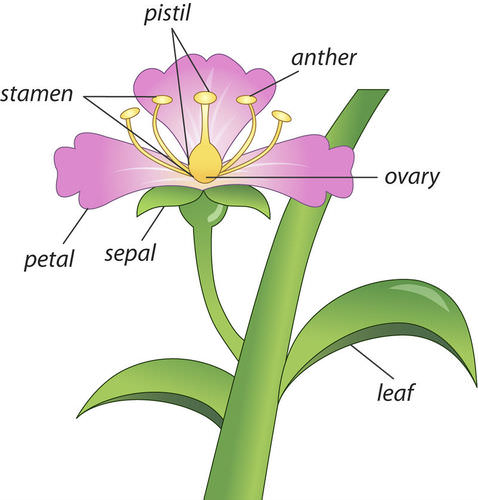
Animals: The heart is an organ made from muscle and nerve tissue and pumps blood around the body. Other examples of animal organs include the liver, brain, lungs, stomach, intestines, kidneys, bladder, and skin.Image: Vecteezy.com. Public domain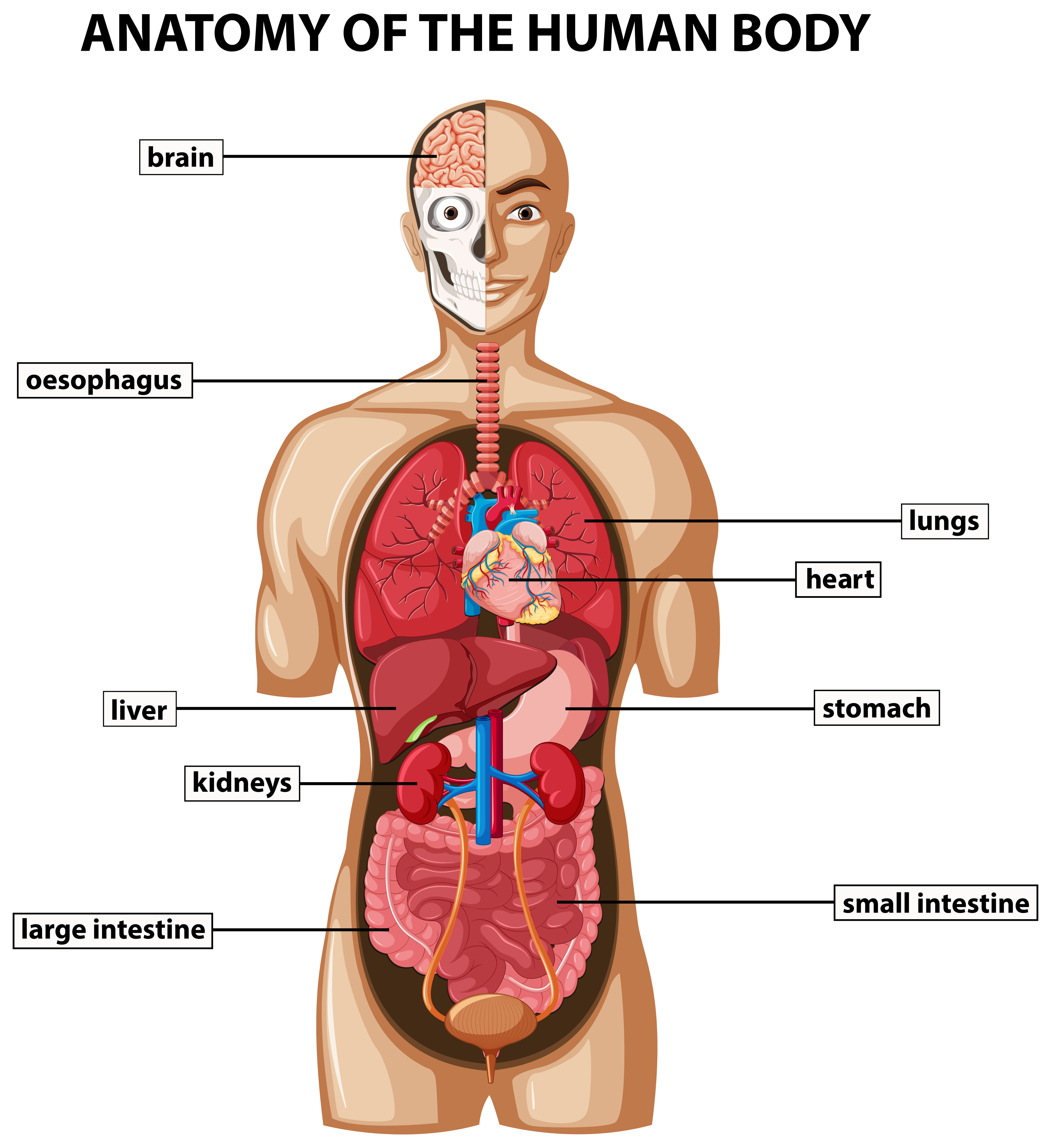
The human body contains five organs that are considered vital for survival. They are the heart, brain, kidneys, liver, and lungs. If any of the five vital organs stops functioning, the death of the organism is imminent without medical help.
The heart is in the center of the chest, and its function is to keep blood flowing through the body. Blood carries substances to cells that they need and carries away wastes from cells.
The brain is in the head and functions as the body’s control center. It is the seat of all thoughts, memories, perceptions, and feelings.
The two kidneys are in the back of the abdomen on either side of the body. Their function is to filter blood and form urine, which is excreted from the body.
The liver is located on the right side of the abdomen. It has many functions, including filtering blood, secreting bile that is needed for digestion, and producing proteins necessary for blood clotting.
The two lungs are located on either side of the upper chest. Their main function is exchanging oxygen and carbon dioxide with the blood.
Your skin is your largest organ and plays a vital role in detecting hot and cold, regulating your body temperature, and protecting your muscles, bones and internal organs from outside infection and disease.
Here are some interesting facts about your skin:
- The average person’s skin covers an area of 2 square meters.
- The average adult has approximately 4 kg's of skin which contains 18 km of blood vessels.
- The average person has about 300 million skin cells. A 6.5 square centimetre of skin has about 19 million cells and up to 300 sweat glands.
Plants: Plants have two organ systems.Organ systems: Two or more organs with the same function is an organ system.
The shoot organ system in a plant is made from leaves, stems, buds, fruits, and flowers.
The root organ system of most plants are all the parts that are underground.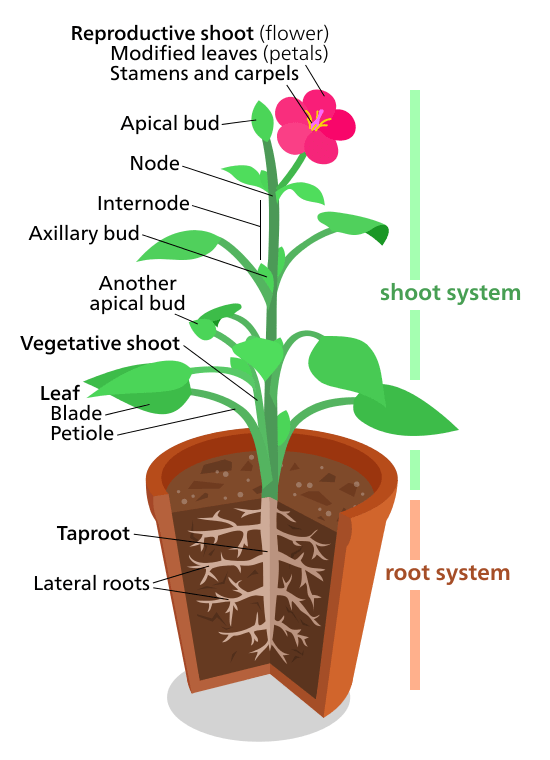
Image: Kelvinsong. CC BY SA 3.0
Animals: There are 11 organ systems in the human body that each have a different function.
Here are some examples:Organ system
Main tissues and organs
Function
Circulatory. The circulatory system circulates the blood in the body.
Blood, blood vessels like the arteries, veins, capillaries, and heart.
Transports substances in the blood around the body.
Maintenance of uniform temperature,
Supply of oxygen and nutrition to all the cells and tissues
Collection of waste matter and transport it to the urinary system.
Respiratory. The respiratory system helps in gaseous exchange
Nose, larynx, bronchi, and lungs.
Takes in oxygen, removes carbon dioxide
Digestive. This system is meant to break down the food and absorb nutrients into the blood circulation.
Mouth, teeth, oesophagus, stomach, liver, pancreas, intestine, rectum, and anus.
Breaks down food, absorbs nutrients
Musculoskeletal system.
This system provides support and movement.
Muscles. Bones.
Responsible for the movements of the body.
They provide the body with a proper shape, frame, and support for the organs.
Nervous system.
This is called the master body system, as it controls all the other organ systems of the body.
Brain, spinal cord, and nerves.
The nervous system regulates whole-body functions, and movements.
It stimulates the release of hormones when needed to control other systems.
It regulates body movements through muscles and controls respiration, heartbeat, digestion, urination etc.
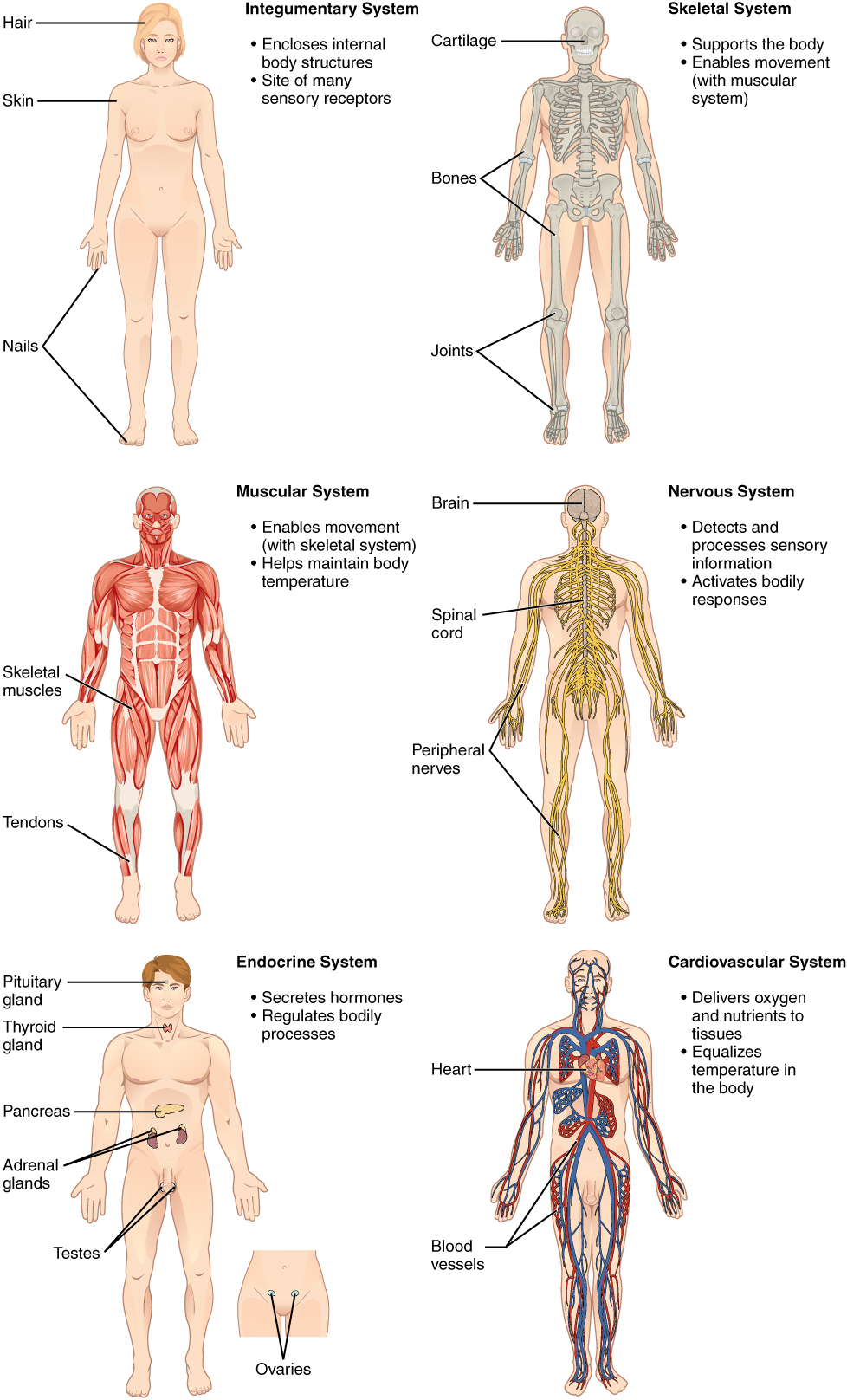
Image: Human Biology. CCA NC 4.0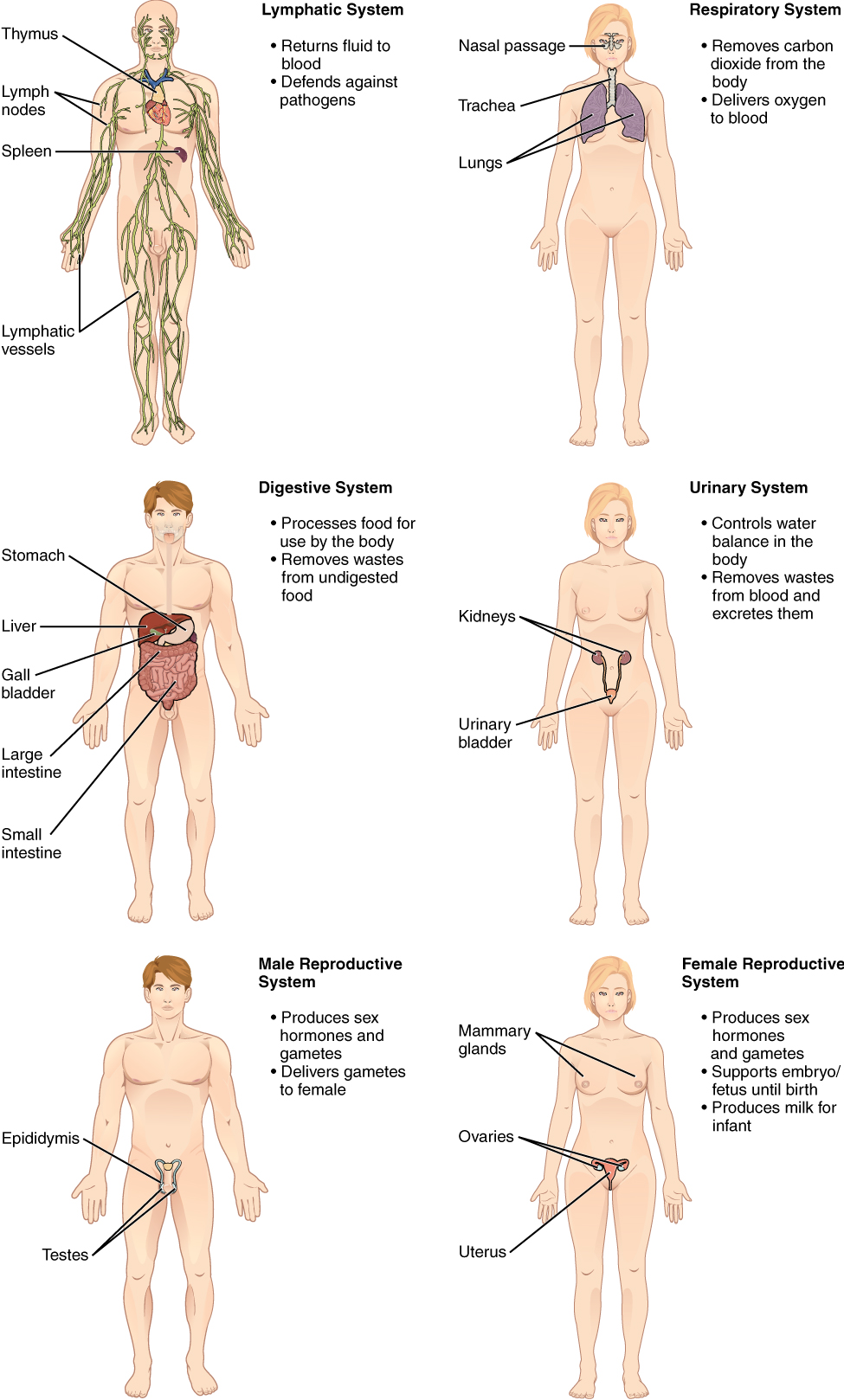
Image: Human Biology. CCA NC 4.0
Credit: Fuse Schools - Global Education
-